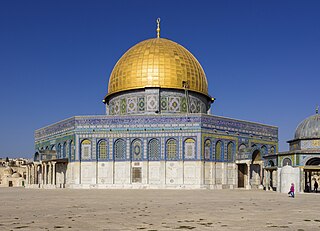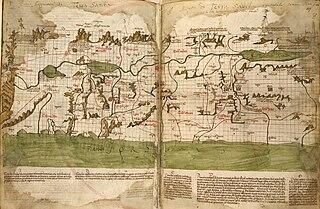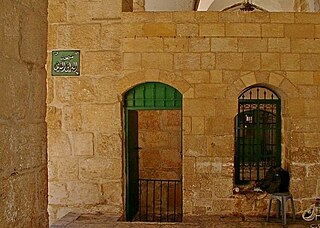Related Research Articles

The Temple Mount, also known as al-Ḥaram al-Sharīf, al-Aqsa Mosque compound, or simply al-Aqsa Mosque, and sometimes as Jerusalem's sacredesplanade, is a hill in the Old City of Jerusalem that has been venerated as a holy site in Judaism, Christianity, and Islam for thousands of years.

The Dome of the Rock is an Islamic shrine located on the Temple Mount in the Old City of Jerusalem, a site also known to Muslims as the al-Haram al-Sharif or the Al-Aqsa Compound. Its initial construction was undertaken by the Umayyad Caliphate on the orders of Abd al-Malik during the Second Fitna in 691–692 CE, and it has since been situated on top of the site of the Second Jewish Temple, which was destroyed by the Romans in 70 CE. The original dome collapsed in 1015 and was rebuilt in 1022–23. The Dome of the Rock is the world's oldest surviving work of Islamic architecture.

Al-Aqsa Mosque or Jami' Al-Aqsa, also known as the Qibli Mosque, is a congregational mosque or prayer hall in the Old City of Jerusalem. In some sources the building is also named al-Masjid al-'Aqṣā, but this name and its English translation "Al Aqsa Mosque" itself, is disputed as it can instead apply to the whole compound in which the building sits. The wider compound is also known as the Haram al-Sharif, the Al-Aqsa Mosque compound, and the Temple Mount.

The Holy Land is an area roughly located between the Mediterranean Sea and the Eastern Bank of the Jordan River, traditionally synonymous both with the biblical Land of Israel and with the region of Palestine. The term "Holy Land" usually refers to a territory roughly corresponding to the modern State of Israel and the Palestinian territories. Jews, Christians, and Muslims regard it as holy.

Names of Jerusalem refers to the multiple names by which the city of Jerusalem has been known and the etymology of the word in different languages. According to the Jewish Midrash, "Jerusalem has 70 names". Lists have been compiled of 72 different Hebrew names for Jerusalem in Jewish scripture.

The Israʾ and Miʿraj are the two parts of a Night Journey that, according to Islam, the Islamic prophet Muhammad (570–632) took during a single night around the year 621. Within Islam it signifies both a physical and spiritual journey. A brief sketch of the story is in the 17th chapter of the Quran, called al-Isra', while greater detail is found in the hadith; later collections of the reports, teachings, deeds and sayings of Muhammad.

Solomon's Stables is an underground vaulted space now used as a Muslim prayer hall by the name of Al-Marwani Mosque, some 600 square yards in area, at the bottom of stairs which lead down from the al-Aqsa Mosque, under the al-Aqsa Mosque, to the base of the southern wall of the enclave of al-Aqsa Mosque in Jerusalem. Al-Marwani Mosque is located under the southeastern corner of the al-Aqsa Mosque compound, 12.5 m (41 ft) below the courtyard, and feature twelve rows of pillars and arches. In December 1996 the Waqf converted the area into a prayer hall by adding lights and floor tiles, and renamed it the El-Marwani Prayer Hall.

The holiest sites in Islam are predominantly located in Western Asia. While the significance of most places typically varies depending on the Islamic sect, there is a consensus across all mainstream branches of the religion that affirms three cities as having the highest degree of holiness, in descending order: Mecca, Medina, and Jerusalem. Mecca's al-Masjid al-Haram, Medina's al-Masjid an-Nabawi, and Jerusalem's Temple Mount are all revered by Muslims as sites of great importance.

The Temple Mount, located in Jerusalem, has twelve gates, one of which, Bab as-Sarai, is now closed to the public but was open during Ottoman rule. There are also six other sealed gates. This does not include the Gates of the Old City of Jerusalem which circumscribe the external walls except on the east side.

The siege of Jerusalem (636–637) was part of the Muslim conquest of the Levant and the result of the military efforts of the Rashidun Caliphate against the Byzantine Empire in the year 636–637/38. It began when the Rashidun army, under the command of Abu Ubayda, besieged Jerusalem beginning in November 636. After six months, the Patriarch Sophronius agreed to surrender, on condition that he submit only to the Caliph. According to Islamic tradition, in 637 or 638, Caliph Umar traveled to Jerusalem in person to receive the submission of the city. The Patriarch thus surrendered to him.

The Islamic Museum is a museum on the Temple Mount in the Old City section of Jerusalem. On display are exhibits from ten periods of Islamic history encompassing several Muslim regions. The museum is west of al-Aqsa Mosque, across a courtyard.

Both Sunni Muslims and Shia Muslims agree on the three Holiest sites in Islam being, respectively, the Masjid al-Haram, in Mecca; the Al-Masjid an-Nabawi, in Medina; and the Al Aqsa Mosque compound, in Jerusalem.

The al-Buraq Mosque is a subterranean mosque next to the Western Wall, located in the southwest corner of the Masjid al-Aqsa compound in the Old City of Jerusalem. This mosque is called al-Buraq Mosque because of a ring that is nailed to its wall where Muslims believe Muhammad tied the Buraq that carried him from the al-Haram Mosque to the al-Aqsa Mosque during the Night Journey.

The Islamization of the Temple Mount is the historical process by which Muslim authorities have sought to adapt the Temple Mount for Muslim use. Once an Israelite and subsequently Jewish holy site, as the location of the Second Temple, the site was subsequently the location of a Roman pagan temple, a Byzantine public building, possibly a church, a garbage dump, and later the Dome of the Rock and the Al-Aqsa Mosque. The Temple Mount is the holiest site in Judaism, and the third holiest in Sunni Islam.
Al-Juʽranah is a village in Makkah Province, in western Saudi Arabia. It is located 18 miles northeast of Mecca.

The Islamization of Jerusalem refers to the process through which Jerusalem and its Old City adopted an Islamic atmosphere of influence and eventually a significant Muslim presence. The foundation for Jerusalem's Islamization was laid by the Muslim conquest of the Levant, and began shortly after the city was besieged and captured in 638 CE by the Rashidun Caliphate under Umar ibn al-Khattab, the second Rashidun caliph. The second wave of Islamization occurred after the fall of the Kingdom of Jerusalem, a Christian state that was established after the First Crusade, at the Battle of Hattin in 1187. The eventual fall of the Crusader states by 1291 led to a period of almost-uninterrupted Muslim rule that lasted for seven centuries, and a dominant Islamic culture was consolidated in the region during the Ayyubid, Mamluk and early Ottoman periods. Beginning in the late Ottoman era, Jerusalem’s demographics turned increasingly multicultural, and regained a Jewish-majority character during the late-19th and early-20th centuries that had not been seen since the Roman period, which largely ended the Jewish presence in the region.
Umar's Assurance, or al-ʿUhda al-ʿUmariyya, is an assurance of safety given by the Caliph Umar ibn al-Khattab to the people of Aelia, the Late Roman name for Jerusalem. Several versions of the Assurance exist, with different views of their authenticity.

The Al-Aqsa Mosque compound in the Old City of Jerusalem has four minarets in total: three on the western flank and one on the northern flank.
Abu Bakr Muhammad ibn Ahmad al-Wasiti was the preacher (khatib) of al-Aqsa Mosque in 1019–1020, the year he wrote a treatise entitled Concerning the (religious) status of Jerusalem, better known as Fada'il Bayt al-Muqaddas, also spelled Fada'il al-Bayt al-Maqdis, literally "Merits/Virtues of Jerusalem".